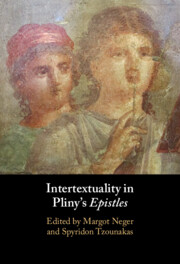Book contents
- Intertextuality in Pliny’s Epistles
- Intertextuality in Pliny’s Epistles
- Copyright page
- Contents
- Contributors
- Acknowledgements
- Abbreviations
- Introduction
- Part I Intertextuality and Interdiscursivity in Pliny’s Letters
- Part II Models and Anti-Models: Pliny’s Interaction with Oratory and Natural History
- Part III Pliny and Seneca: Discourses of Grief and Posthumous Reputation
- Part IV Pliny’s Villas and Their Poetic Models
- Part V Pliny Turns Nasty: Satire and the Scoptic Tradition
- Part VI Final Thoughts: Discourses of Representation and Reproduction
- Chapter 14 Pliny’s Calpurnia: Filiation, Imitation, Allusion
- Bibliography
- General Subject Index
- Index Locorum
Chapter 14 - Pliny’s Calpurnia: Filiation, Imitation, Allusion
from Part VI - Final Thoughts: Discourses of Representation and Reproduction
Published online by Cambridge University Press: 07 September 2023
- Intertextuality in Pliny’s Epistles
- Intertextuality in Pliny’s Epistles
- Copyright page
- Contents
- Contributors
- Acknowledgements
- Abbreviations
- Introduction
- Part I Intertextuality and Interdiscursivity in Pliny’s Letters
- Part II Models and Anti-Models: Pliny’s Interaction with Oratory and Natural History
- Part III Pliny and Seneca: Discourses of Grief and Posthumous Reputation
- Part IV Pliny’s Villas and Their Poetic Models
- Part V Pliny Turns Nasty: Satire and the Scoptic Tradition
- Part VI Final Thoughts: Discourses of Representation and Reproduction
- Chapter 14 Pliny’s Calpurnia: Filiation, Imitation, Allusion
- Bibliography
- General Subject Index
- Index Locorum
Summary
The chapter explores the anxious cultural construction of women as intergenerational mediators that emerges from several epistles in Pliny’s collection (3.3 and 4.19; 4.2 and 4.7; 2.7 and 3.10). At once expected to be bearers of their father’s imprint and vehicle for the transmission of their husband’s identity, Roman women were the object of a discourse in which notions of biological filiation significantly intersected with issues of artistic reproduction and literary allusion. Building a typology of intra-, inter-, extra-, and alter-textual relations which connect Pliny’s topic and diction to relevant passages in Martial (6.37 and 38) and Tacitus (Dial. 28-29), my argument illuminates some crucial, common semiotic practices in his age.
Keywords
- Type
- Chapter
- Information
- Intertextuality in Pliny's Epistles , pp. 281 - 303Publisher: Cambridge University PressPrint publication year: 2023

